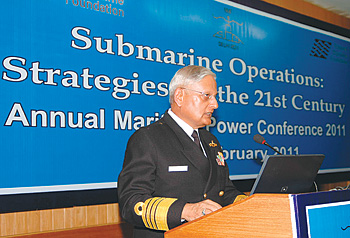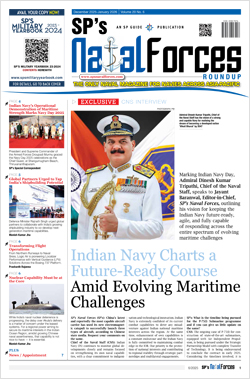INDIAN ARMED FORCES CHIEFS ON OUR RELENTLESS AND FOCUSED PUBLISHING EFFORTS

The insightful articles, inspiring narrations and analytical perspectives presented by the Editorial Team, establish an alluring connect with the reader. My compliments and best wishes to SP Guide Publications.

"Over the past 60 years, the growth of SP Guide Publications has mirrored the rising stature of Indian Navy. Its well-researched and informative magazines on Defence and Aerospace sector have served to shape an educated opinion of our military personnel, policy makers and the public alike. I wish SP's Publication team continued success, fair winds and following seas in all future endeavour!"

Since, its inception in 1964, SP Guide Publications has consistently demonstrated commitment to high-quality journalism in the aerospace and defence sectors, earning a well-deserved reputation as Asia's largest media house in this domain. I wish SP Guide Publications continued success in its pursuit of excellence.
- Global Partners Urged to Tap India's Shipbuilding Potential: Rajnath Singh at Samudra Utkarsh
- All about HAMMER Smart Precision Guided Weapon in India — “BEL-Safran Collaboration”
- India, Germany deepen defence ties as High Defence Committee charts ambitious plan
- G20 Summit: A Sign of Global Fracture
- True strategic autonomy will come only when our code is as indigenous as our hardware: Rajnath Singh
- India–Israel Joint Working Group Meeting on defence cooperation to boost technology sharing and co-development
Conference
Submarine Operating Strategies

Speaking at a seminar organised on the sixth anniversary of the National Maritime Foundation, Chief of Naval Staff Admiral Nirmal Verma said that the Indian Navy envisages the utility of submarines not only for littoral operations, but also for sea-based deterrence and a fleet support role, and therefore our submarine force structure would be an appropriate mix of conventional and nuclear submarines
As part of the anniversary celebrations of the National Maritime Foundation (NMF), a series of Annual Maritime Power Conference was launched on February 16, 2006. Since then six conferences have been held at India Habitat Centre, New Delhi. The conference on “Maritime Dimensions of the New World Order” was organised on February 16 and 17, 2006; “Freedom of the Seas: a Contemporary Outlook” on February 13-14, 2007; “Contemporary Transnational Challenges International Connectivity” on February 14-15, 2008; “Port Sector: Developments and Security” on February 18-19, 2009; “Aircraft Carriers in the Early 21st Century” on February 10-11, 2010; and “Submarine Operations: Strategies for the 21st Century” was organised on February 16-17, 2011.
The sixth edition of the annual event was an international conference on “Submarine Operations: Strategies for the 21st Century” organised with the aim to bring together professionals and to provide a meeting ground for the growing number of submarine owning navies and other entities involved with submarine construction, maintenance and operations. The pronounced objectives of the conference were submarine operations experience; futuristic submarine construction including a discussion on concepts of mission modularity, life time modularity and costs; emerging technologies trends with respect to weapons, sensors and communications; role of submarines in joint operations; merits/demerits and modalities of integrating submarines into the C4ISR network; synergy between Special Forces and submarines; submarine radiated noise and signature management; aspects related to submarine search and rescue; relevance of non-nuclear submarines; and role of submarines in low intensity maritime operations scenario and countering of asymmetric threats.
In his inaugural address, Admiral Nirmal Verma, Chief of the Naval Staff (CNS) observed, “it seems abundantly clear as we step into the second decade of the 21st century that submarines continue to remain vital elements of the military and security strategies of many nations and an important component of international security calculus. This is despite the fundamental changes to the strategic environment in the past two decades, the overall threat perception in various parts of the world, and the emergence of new challenges the world over that we term unconventional threats. It is logical, therefore, to assume that the strategies for submarine operations will continue to be driven by the overall geopolitical and military strategies of nations. Submarines continue to provide unique capabilities and inherent advantages to the arsenals of those that possess them.”
Many modern navies operate only conventional submarines, some major submarine operating navies started with conventional platforms but later opted to operate only nuclear submarines. Perhaps the planning dilemma of achieving the right force-mix would need an indigenous solution for each navy. The CNS elaborated that the “Indian Navy envisages the utility of submarines not only for littoral operations, but also for sea-based deterrence and a fleet support role. Therefore, our submarine force structure would be an appropriate mix of conventional and nuclear submarines, and our future building and operating strategies will reflect this reality. We have been operating submarines for over 40 years and are now enhancing our capacity to build submarines. With the launch of the Arihant and the rolling out of the Scorpene production line, we have made further progress on the path of selfreliance. In the coming decades, we hope to have developed a vibrant submarine building programme. Given the strategic importance of this field, it is important for us to strengthen indigenous capabilities to design and build submarines and become self-reliant in doing so.”





